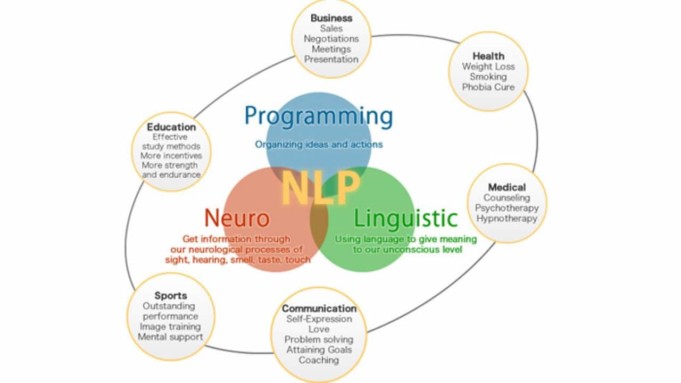Neuro-linguistic programming (NLP) is a psychological technique that includes studying and implementing effective individual methods to achieve a personal objective.
It relates the feelings, vocabulary, and patterns of action that have been learned through experience to particular outcomes.
Proponents of Neuro-Linguistic Programming believe that all human behaviors are productive. Therefore, whether the strategy fails or the unexpected occurs, the experience is neither positive nor bad — it provides more valuable knowledge.
History of neuro-linguistic programming
Neuro-Linguistic Programming was developed in the 1970s at the University of California, Santa Cruz. The primary founders are John Grinder, a linguist, and Richard Bandler, an information scientist and mathematician. Judith DeLozier and Leslie Cameron-Bandler have also contributed to the area, as have David Gordon and Robert Dilts.
Grinder and Bandler’s first book on Neuro-Linguistic Programming, Structure of Magic: The Language of Therapy, was published in 1975. In this publication, they aimed to illustrate particular communication patterns that, apart from others, described communicators as excellent.
Much of the book is based on the works of Virginia Satir, Fritz Perls, and Milton Erickson. It also incorporated approaches and ideas from other well-known mental health experts and Linguists such as Carlos Castaneda, Gregory Bateson, Alfred Korzybski, and Noam Chomsky.
The result of Bandler and Grinder’s work was the development of the Neuro-Linguistic Programming meta-model, a technique they believed could identify language patterns that reflected basic cognitive processes.
Interest in Neuro-Linguistic Programming grew in the late 1970s after Bandler and Grinder began marketing the approach as a tool for people to learn how others achieve success.
Today, Neuro-Linguistic Programming is used in various fields, including counseling, medicine, law, business, the performing arts, sports, the military, and education.
How neuro-linguistic programming works
Modeling, action, and efficient communication are essential elements of neuro-linguistic programming. The assumption is that if an individual can understand how another person executes a task, the process can be copied and transmitted to others so that they, too, can achieve the same results.
Neuro-Linguistic programming advocates claim that everybody has a personal map of reality. The ones who practice Neuro-Linguistic Programming analyze their own and other perspectives to create a systematic overview of one situation.
By understanding a range of perspectives, the Neuro-Linguistic Programming user gets the details. Advocates of this school of thought claim that the senses are essential to processing available knowledge and that the body and mind influence each other.
Neuro-Linguistic programming is an experiential technique. Therefore, if a person wants to understand the action, they must do the same thing to learn from the experience.
Neuro-Linguistic Programming practitioners believe there are natural hierarchies of learning, communication, and change.
The six logical levels of change are:
- Purpose and spirituality: This can be used in something greater than oneself, such as religion, ethics, or some other process. This is the greatest degree of change.
- Identity: Identity is the person you see yourself as being, and it includes your commitments and the roles you play in life.
- Beliefs and values: these are personal belief systems and the values that matter to you.
- Capabilities and skills: these are your abilities and what you can do with them.
- Behaviors: Behaviors are the basic actions you undertake.
- Environment: The environment would be the background or setting, and any other people around you. This is the lowest degree of change.
Each logical level aims to organize and guide the information below it. As a consequence, making changes at a lower level can lead to changes at a higher level.
However, having a higher-level adjustment would often result in lower-level changes, according to the Neuro-Linguistic Programming Theory.
Neuro-linguistic programming in therapy
It can be summed up by saying, “The map is not the territory,” since it shows the gaps between faith and truth. It points out that each person works within their own viewpoint rather than from a position of objectivity.
NLP advocates claim that everyone’s view of the world is warped, constrained, and unique. Therefore, a therapist who practices NLP must consider how a person in treatment perceives their “map” and how this perception can influence their thoughts and actions.
The map of the world of the person is created from the data obtained by the senses. This knowledge can be auditory, visual, olfactory, gustatory, or kinesthetic.
Practitioners of the Neuro-linguistic program agree that this knowledge varies individually in terms of quality and significance and that-person processes experience using the Primary Representational System (PRS).
In order for the NLP therapist to interact successfully with an individual in their care, the therapist must strive to match that individual’s PRS to use their map.
Neuro-linguistic programming practitioners believe it is possible to access representational systems using cues, such as eye movements.
Neuro-linguistic programming therapists work with people to understand their aspirations, behavioral and thinking patterns, and emotional state.
By assessing a person’s map, the therapist can help them discover and strengthen the skills that serve them best and help them develop new strategies to replace unproductive ones. This technique can help individuals in therapy reach treatment goals.
Neuro-linguistic programming supporters claim the approach produces fast, lasting results and improves understanding of cognitive and behavioral patterns.
Neuro-linguistic programming also seeks to build effective communication between conscious and unconscious mental processes to increase creativity and problem-solving skills.
Some advocates compare the Neuro-linguistic programming to cognitive behavioral therapy (CBT) but affirm that progress can be made with NLP in a shorter time frame.
Since its development, neuro-linguistic programming has been used to treat different issues.
These include:
- Post Traumatic stress
- Anxiety and Depression
- Schizophrenia
- Phobias and panic
- Communication issues
- Borderline personality
- Attention-deficit hyperactivity
- Addiction
- Obsessions and compulsions
Neuro-linguistic programming research
While limited in number, scientific studies have explored the efficiency of Neuro-linguistic programming as a treatment tool.
In a 2013 study, researchers examined whether language and visualization methods used in neuro-linguistic programming can enable children with special education to be better prepared for classroom learning.
Researchers concluded that NLP approaches have helped children develop a healthy state of mind conducive to learning. However, it was also clarified that these were ‘brief, tentative assumptions.’ In addition to other limitations, the sample consisted of only seven children.
Neuro-linguistic programming practitioners say that eye movement can be a reliable predictor of lie detection. Researchers tested this assertion in a series of three studies in 2012.
In the first sample, the eye movements of participants who were telling the truth or lying did not match the proposed neuro-linguistic programming patterns.
In the second analysis, one group was told of the NLP eye movement theory, while the control group was not. However, there was no substantial difference between the two groups following a lie detection test.
In the third sample, the eye movements of each community were encoded at public press conferences. Again, there was no noticeable difference in eye movements between them.
A systematic review of the impact of Neuro-linguistic programming on health was conducted by researchers in 2012. Ten studies addressing substance abuse, anxiety, weight management, morning sickness, and claustrophobia were evaluated in this review.
The researchers concluded that while strong evidence did not exist of Neuro-linguistic programming being ineffective, there was little evidence to suggest Neuro-linguistic programming interventions improved health.
Concerns and limitations of Neuro-linguistic programming
Because of its eclectic nature, neuro-linguistic programming is difficult to describe as a treatment modality. The most obvious limitation of neuro-linguistic programming is undoubtedly the lack of empirical evidence to support many influential advocates’ arguments.
While numerous testimonials praise the approach, few scientific studies provide firm, unbiased proof that it is a useful treatment model for mental health issues. Neuro-linguistic programming co-founder Richard Bandler has often voiced disagreement with the scientific testing of Neuro-linguistic programming.
Additionally, the lack of regulation in training and certification has resulted in many individuals becoming Neuro-linguistic programming practitioners despite lacking credible experience or mental health background.
References;
- Neuro- Linguistics Programming; Goodtherapy
- What is NLP?; NLP












